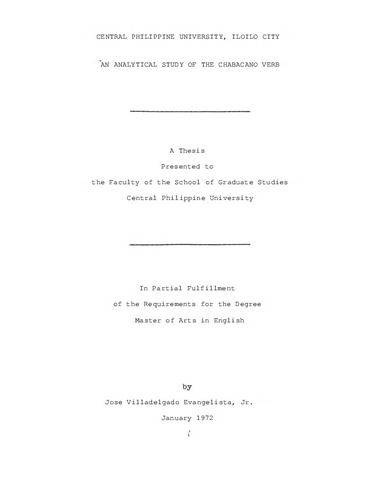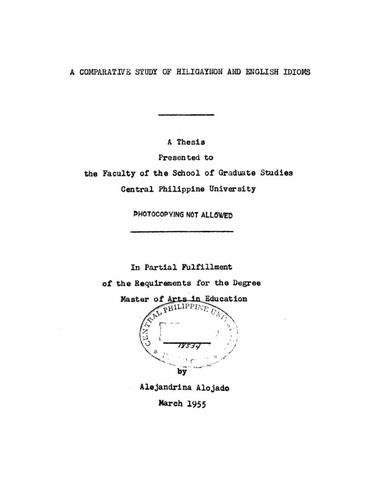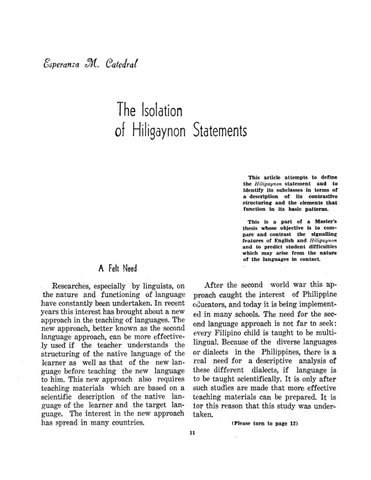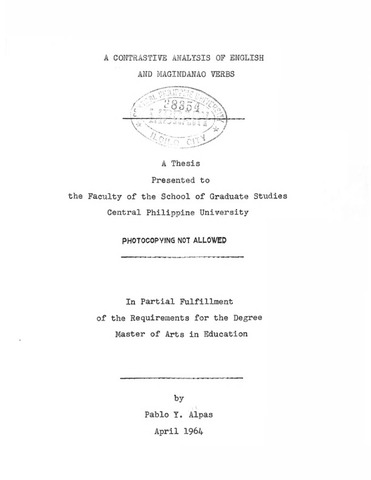An analytical study of the Chabacano verb
摘要
The present investigation is limited to the isolation and description of Chabacano verbs and a comparison of their features with those of English verbs, to the end that the structural differences between Chabacano verbs and English verbs may be revealed, and the difficulties which a Chabacano student is likely to have in learning English may be anticipated.
These specific questions were answered: (1) Which of the Chabacano sentences contain verbs and which do not? (2) How are Chabacano verbs formed? (3) How many types of verbs are there in Chabacano? (4) How are they distributed or arranged in a Chabacano sentence? and (5) Structurally, how do Chabacano verbs differ from English verbs?
The corpus of this study was taken from recordings of conversations, a reader, and some themes written by college students. All these were obtained in the City of Zamboanga.
After every selection was reduced to its separate sentences and translated, all the identifiable verbs were underlined. Then the ratio of verbless sentences to sentences with verbs was noted, and the sentences were classified according to use. Next, a description of the distinguishing formal features and characteristic distribution of the isolated Chabacano verbs was attempted, and an authoritative description of English verbs was obtained. English verbs and Chabacano verbs were later compared and contrasted as to structuring and distribution. Finally, the possible sources of difficulty for Chabacano speakers learning English were isolated and evaluated for their implications in the teaching and learning of English as a second language.
The following are the findings of the study:
1. Chabacano verbs are words that refer to some kind of “action.” Therefore, only the Chabacano sentences that indicate action have verbs.
2. Chabacano has three types of verbs, judging from their behavior: Type 1, the “general” verb tiene; Type 2, the modal verbs; and Type 5, the action verbs.
3. Chabacano verbs are usually uninflected.
4. The beginning of utterances is the preferred position of a Chabacano verb.
5. Chabacano verbs and English verbs are similar in that they may be preceded by function words, and they may be distinguished from some other classes by accent.
Chabacano verbs differ from English verbs in the utilization of inflection, in positions they commonly occupy in the sentence, and in the utilization of derivational affixes.
It is anticipated that the Chabacano speaker learning English is likely to encounter some difficulty in the following: (a) the third-singular inflection of English verbs, (b) the formation of verb phrases, (c) the construction of different types of sentences which are signaled by a change in verb position, and (d) the use of derivational affixes to form English verbs.
In the light of the foregoing, the writer recommends:
1. That materials for the teaching of English verbs to Chabacano-speaking students of Zamboanga be developed and prepared, with emphasis given to the structural differences between the English verb and the Chabacano verb—the expected major source of difficulty.
2. That Chabacano nouns and other word classes be also studied in order to round out the description of Chabacano.
描述
Abstract only
建议引文
Evangelista, J. V. Jr. (1972). An analytical study of the chabacano verb (Unpublished Master's thesis). Central Philippine University, Jaro, Iloilo City.
文件类型
Thesis主题
关键字
部
School of Graduate Studies学位
Master of Arts in English Language and Literature货架位置
GSL Theses 378.242 Ev14
物理描述
157 leaves
The following license files are associated with this item:
Except where otherwise noted, this item's license is described as Attribution-NonCommercial-NoDerivs 3.0 Philippines
相關項目
顯示由標題,作者,創造者和主題相關的項目。
-
A comparative study of Hiligaynon and English idioms
Alojado, Alejandrina (1955)When teachers of English get together and talk shop they complain of the weaknesses of their classes both in oral speech and in written work. This observation is not of the English teachers alone but also of other educators ... -
The isolation of Hiligaynon statements
Catedral, Esperanza M. (Central Philippine University, 1965-01)This article attempts to define the <em>Hiligaynon</em> statement and to identify its subclasses in terms of a description of its contrastive structuring and the elements that function in its basic patterns. This is a ... -
A contrastive analysis of English and Magindanao verbs
Alpas, Pablo Y. (1954)After the Second World War, there appeared two camps of opinion concerning the teaching of English in the Philippines. The first camp is composed of those who cling to the use of English grammars based on Latin models and ...







